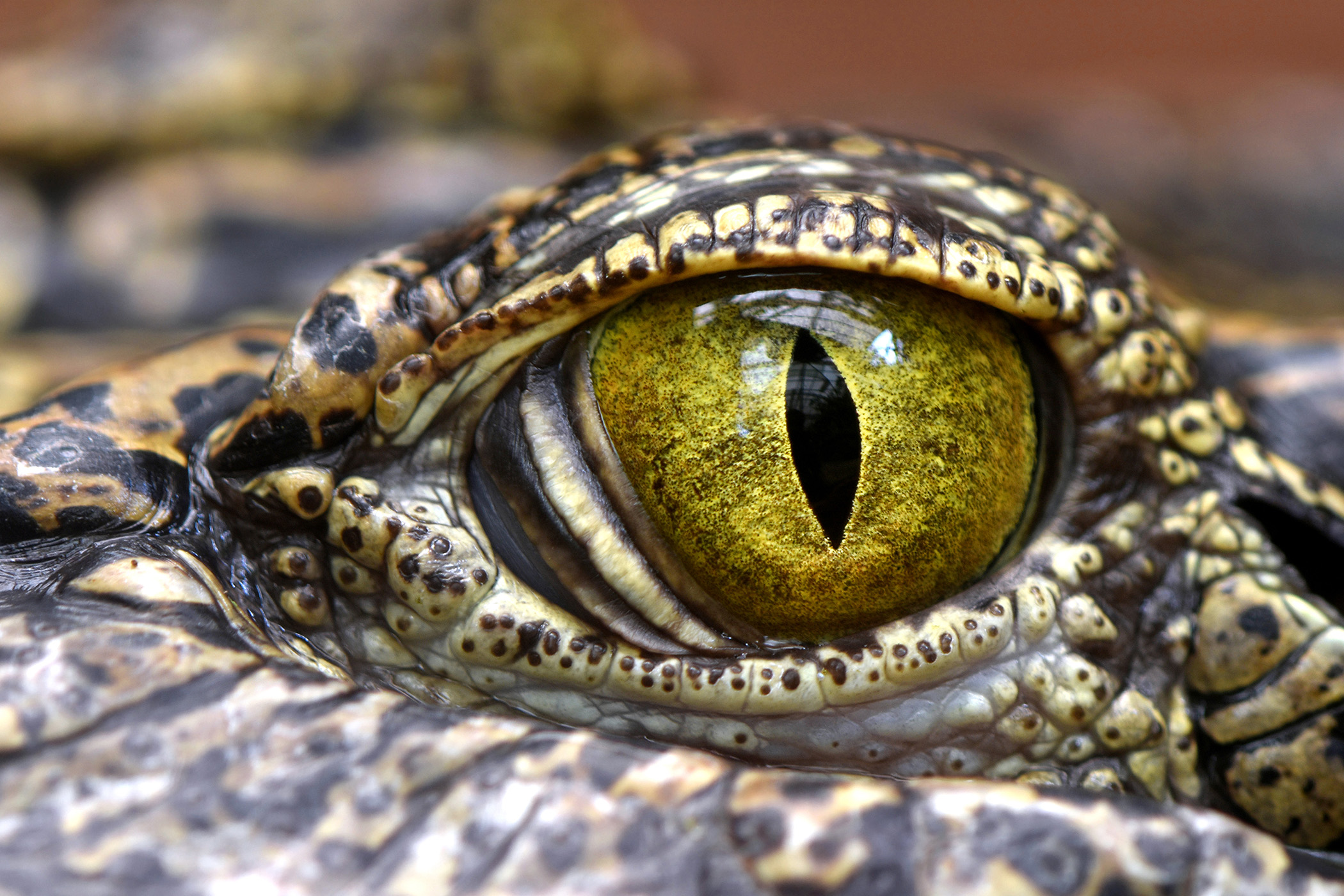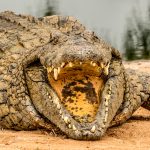No one really knows how many humans are killed and eaten by crocodiles every year.
Photo above: Crocodiles are able to lie in the water with just their eyes, nostrils, and a bit of upper cranium showing, a posture perfectly suited to ambushing unsuspecting prey.
Not counting herpetologists and other strange folk, most people who spend much time around wild crocodiles tend to dislike them intensely.
“Crocodiles are the enemies of all life, and should always be slaughtered without any compunction,” wrote the famous hunter Major W. Robert Foran in his classic 1933 book, Kill Or Be Killed. “Nobody should ever hesitate to kill one. It is either a murderer many times over or a potential slayer of all living things.” After killing and cutting open a twelve-footer in the Nzoia River, he found, among other items, “a woman’s foot, a man’s hand, some native beads, an assortment of bangles and anklets [and] the hoof of a waterbuck… There could be no doubt about it being a man-killer. I was glad to have been its executioner.”
Peter Capstick had a similar view. “Personally, I hate crocs. The reason is that I fear them. There could be hardly an end more horrible than feeling that death-grip of terrible teeth, knowing there was nothing you could do to save yourself.” In Africa, he added, the crocodile “may accurately be summed up as that land’s only carnivore that will cheerfully kill and eat you every time he gets the chance.”
Hopefully we have advanced from advocating the wholesale slaughter of any wild creature, even dreaded crocodiles, but that being said, it is rather difficult to like these animals, though it is very easy–and I would add, very wise–to fear them. By “them” I mean the fifteen or so worldwide species of crocodilians that frequently attack and kill humans.
Let there be no doubt, when some types of crocodiles become large enough, they don’t “turn” into man-eaters, as the atypical lion or leopard might. For a croc of a certain size, man-eating isn’t an aberrant departure from normal, human-avoiding behavior; it simply will feed on people whenever it gets an opportunity. And from a crocodile’s perspective, why not? Prey is prey, and humans, when ambushed or surprised, can be fairly easy to catch, rend into consumable pieces, and swallow. Large crocs will also attack people for reasons other than predation, as I’ll explain later. Even a beast with a full belly might take a chomp at you in certain circumstances.
But, you might ask, putting aside all dislike, fear, and sensationalism, just how common are actual attacks? How many people do the crocodilians seriously injure or kill each year?
The most honest answer is: no one really knows. Even conservative, science-based compilations always include necessary disclaimers such as: “the record of attacks we receive are a small fraction of the attacks that actually occur worldwide,” and “the vast majority of attacks are not reported or are only reported at the local level.” Whole regions in Africa, for example–entire countries–have or issue no record or reports of croc attacks. This is also true throughout much of Indonesia, Malaysia, Sri Lanka, the Philippines, and many other areas where the large and aggressive saltwater or estuarine crocodile (Crocodylus porosus) is a frequent threat to humans. Many places report some fatal attacks but leave out the frequent serious non-fatal cases where people have lost an arm or leg or are permanently crippled and disfigured. So if you read in a recent, scholarly reference that “between 2008 and mid-2013 there were 1,237 attacks worldwide, resulting in 674 fatalities,” understand that these numbers are far below the reality. There are knowledgeable people who would argue that two or three times that many attacks and deaths occur annually just in Africa alone.
But there are still things to be learned from the incomplete stats. For instance, they reveal that croc dangers are by no means limited, as some people believe, to Africa and northern Australia (where the saltwater croc or “saltie,” is a well-known threat). Salties, as already noted, have an extremely large range, and anyone traveling to those areas, whether to hunt or simply vacation, should be aware of the mostly unpublicized danger. This also applies to parts of Mexico, where many tourists would be shocked to learn that crocodiles can be a deadly menace. In 2015, Mexico reported 27 attacks and 7 deaths attributed to the American crocodile (C. acutus, which can grow to 19 feet in length and also inhabits southern Florida, Central America and parts of South America,) and Morelet’s crocodile (C. moreletti). Attacks occur on both the west and east coasts, including the popular tourist region of Cancun. The lesson in brief: if you are traveling to a tropical or sub-tropical region anywhere in the world, look into the local (often unmentioned because it’s bad publicity) potential for croc trouble. It could very well be a real danger.
By far the worst croc culprits in terms of the most attacks and fatalities are the Big Two: The large salties and Africa’s Nile crocodile (C. nilocticus). By the known numbers, 88 percent of all croc-caused human deaths are attributed to these two species, divided almost evenly. They deserve a close look, because the more you know about these formidable animals, the better your chances of avoiding or surviving an encounter or attack.
While modern crocodiles are in one sense ancient, dating back at least 160 million years, when they coexisted with dinosaurs, they are not primitive by reptilian standards. They have acute senses, including binocular color vision with vertical pupils that enhance their ability to see well at night. External ear slits (with moveable covering flaps that close before submerging) give them the best hearing of any reptile. This is abetted by nerve-dense sensory glands around the jaws and throughout the body for detecting even slight vibrations in the air and water–an aid both to homing in on prey and sensing the approach of enemies, such as human hunters. They have a keen sense of smell, and their top-positioned nostrils allow them to breathe while maintaining a minimum-exposure position in the water, showing only eyes, nostrils, and a bit of upper cranium, a posture perfectly suited for ambush hunting. Because of salt glands in the tongue which regulate osmosis, “saltwater” crocs can and do live in freshwater, and some freshwater crocs can tolerate brackish, estuarine, or saltwater environments. This means you can be attacked by a saltie in a freshwater river or lake (even far inland), or by a Nile croc near a beachside river mouth. A number of attacks and deaths occur each year because people don’t realize this is possible.
Crocodiles have seventy conical teeth, which vary in size and sharpness. Broken or lost teeth are self-replacing up to forty-five times over an animal’s lifetime. Teeth and jaws are well-designed for grabbing and tearing, but not for chewing. Crocs swallow small prey whole. Larger victims might be whiplashed side to side to break off pieces, which are then gulped down. Larger prey is usually seized in a vise grip and dragged into the water to be drowned. The croc then bites into the carcass and twists in a rapid “death roll,” tearing off limbs or chunks of meat to swallow whole. The bite-force of a large crocodile is said to be one of the strongest in nature, rated at 1.1 tons or more, enough to crush large bones and, in a number of documented cases, to decapitate human victims or sever their bodies in two.
A crocodile is considered man-eater size when it reaches approximately eight feet in length. Crocs this big and larger become increasingly wary and even timid-seeming when they are resting or basking onshore, often fleeing into the water at the first sign of an approaching human. But when hunting, they can be both bold and subtle. Large crocs like to hunt by ambush, barely visible in the water, especially in turbid conditions or when intentionally lying among weeds, floating logs or other surface debris. Although their brains are only walnut-sized, crocs are the most intelligent of reptiles, able to trace and remember the habit patterns of potential prey, including humans. When prey is spotted, the croc swims silently underwater (where it can move up to 20 miles per hour), to gain the best ambush position. At just the right moment, it lunges to grab its victim, usually by lower limbs or head. A large crocodile can vault much of its body length out of the water, canting to grab prey off of a riverbank–or a person out of a boat. Crocs can also lunge onto land, where they are capable of pursuing or chasing in short bursts that have been timed at nearly 10 miles per hour.
Most attacks on humans, whether near or in the water, happen by surprise, “out of the blue”–or more accurately in many cases, out of the murk. Attacks can occur at any time of day, but the risk is generally higher in dim light, at dusk and at night, when crocs are most active and harder to see and avoid. During breeding season, large bulls are territorially aggressive, bolder, and more prone to “defensive” attacks, even on boats. (Their powerful jaws and sharp teeth can puncture an aluminum hull.) Female crocs, after egg-laying, will defend their water-side nests fiercely should a person intentionally or accidentally come near the buried eggs or interfere in any way with the chirping hatchlings. About a third of recorded crocodile attacks are considered defensive rather than predatory. Being poikilothermic–inaccurately called “cold-blooded”–crocs are most active in temperatures between 82 and 92 degrees F., and will become sluggish to dormant near or below 55 degrees.
Let me conclude with a quick review of some do’s and don’ts to avoid or survive croc attacks:
Learn as much as you can about crocodile danger-potential when visiting specific areas. Keep an eye out for the animals or evidence of their presence when near or around water. Look on river banks or shorelines for slide or drag paths of bare earth or flattened vegetation where crocs “haul out” of water to sun-bask and slide back in to return. Slides usually mean that one or more crocodiles are not far away.
Don’t assume a body of water is safe just because no crocodiles or sign are present. Crocs will move to different waters, often travelling overland at night. They can also submerge and stay unseen for up to several hours, or be present but difficult to spot. These animals have evolved for effective ambush, and though hard to believe, a man-eater-sized croc can submerge, wriggle down and hide in as little as twelve inches of water. Crocs might inhabit or visit even very small water holes.
Take great care around water. Crocodiles like to hunt the edges, so don’t walk close to the banks or shoreline. Keep at least fifteen feet from the water’s edge. Don’t lean over banks or the sides of boats. The notion that it’s safe to swim in deep water (because crocs like the shallows) is absolutely false. Many attacks occur in the depths. A crocodile can bite, and swallow, while underwater. Never dangle feet, legs, or arms into the water, even for a few moments. Crocs can and will “map” and remember the habits of potential prey, including humans who wade, river-cross, wash, or fetch water in the same places each day. Avoid such predictable habits. Don’t camp or sleep close to a shore or bank. Crocodiles will leave the water and hunt on land at night; in a number of cases they have stalked into a campground and pulled sleeping humans from tents or shelters. It’s best to camp at least 150 yards from the water’s edge.
What do you do if you are aggressively approached or attacked by a sizeable crocodilian? On land, run away fast. Forget the common instruction to move in a “zig-zag” pattern; the best move is to sprint straight away from the animal and the water. Most crocodiles cannot chase far on land.
If you are grabbed in any circumstance, fight back. Don’t simply struggle to pull away and resist; that often provokes the animal into the “death roll” move that tears off limbs. If on land or in the shallows, do whatever is possible to keep from being dragged into deeper water, even if that means holding onto a tree limb or another person’s outstretched arm. To fight back, aim for the eyes, poking, stabbing, hitting. Next best to target are the comparatively sensitive nostrils and ears. If another person is present, that person should attack the croc’s eyes, nose and ears with whatever’s available. For someone armed, a gunshot to the croc’s head or neck area–it needn’t be precise like a normal hunting kill-shot–usually causes the animal to immediately release and drop away. Even a very large man-eater can often be driven off when confronted by more than one person.
The third option is the palatal valve. This is a flap of tissue behind the tongue that keeps water out of a crocodile’s throat and airway when it opens its mouth or feeds underwater. If a croc has you by the arm or leg, it might be possible to jam that limb down deeper into the mouth, opening the palatal valve, which lets water in and forces the croc to release you.
These tactics might sound like implausible longshots with a huge and powerful man-eater, but they have worked in multiple cases. In one instance, a man being dragged under with his arms pinned did the only thing he could think of: he bit down as hard as he could on the animal’s nose. The surprised croc released him and swam off. The man suffered serious injuries, but survived.











